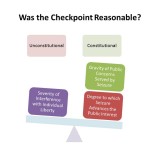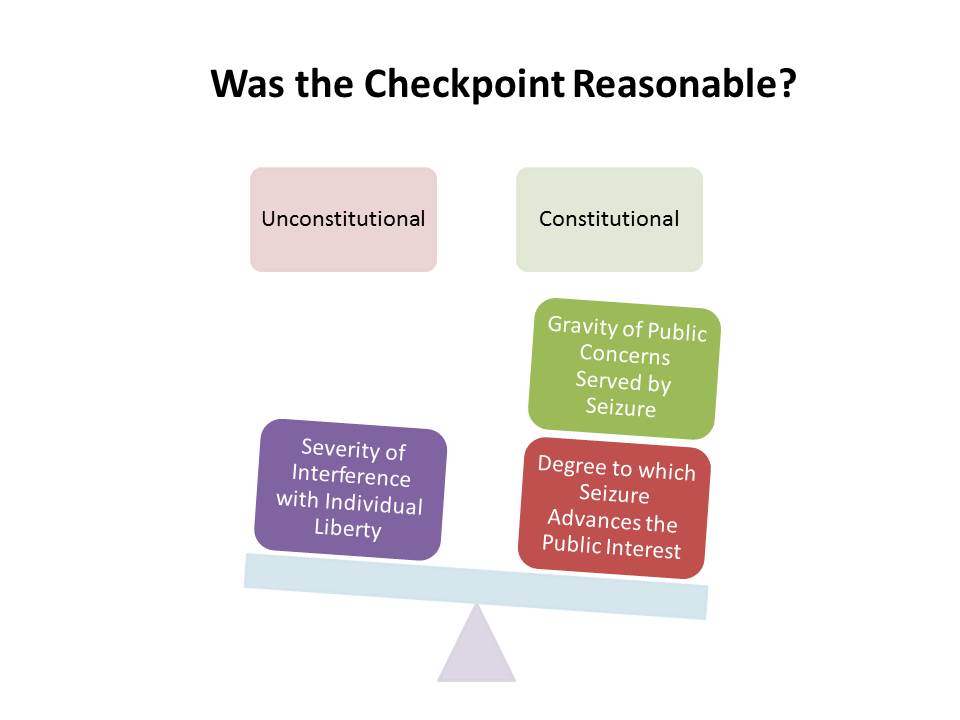The facts. A detective with the Charlotte-Mecklenburg Police Department writes a plan for a checkpoint to be conducted later in the evening. The plan states that the checkpoint will be established at the intersection of Ashley Road and Joy Street in Charlotte, NC. The plan states that the checkpoint’s purpose is to increase police presence in the targeted area while checking for driver’s license and vehicle registration violations. The plan further states that all vehicles traveling through the checkpoint must be stopped unless the officer in charge determines that a hazard has developed or an unreasonable delay is occurring. If that situation arises, all vehicles must be allowed to pass through until the hazard or delay is cleared.
checkpoint’s purpose is to increase police presence in the targeted area while checking for driver’s license and vehicle registration violations. The plan further states that all vehicles traveling through the checkpoint must be stopped unless the officer in charge determines that a hazard has developed or an unreasonable delay is occurring. If that situation arises, all vehicles must be allowed to pass through until the hazard or delay is cleared.
The checkpoint is conducted from 12:34 a.m. to 1:52 a.m. on the designated evening. Every vehicle that travels through the checkpoint is stopped, and the officers ask every driver for his or her driver’s license.
The question. A passenger in a car stopped at the checkpoint moves to suppress evidence obtained during the stop and subsequent search of the car, alleging that the checkpoint was unconstitutional.
If you were the court, how would you rule?
The trial court denied the defendant’s motion to suppress, determining that the checkpoint did not violate the defendant’s constitutional rights. The court of appeals, however, held today in State v. McDonald that the trial court failed to adequately determine the reasonableness of the checkpoint and remanded for additional findings. Trial courts in addition to the one from which McDonald appealed likely will find the opinion helpful as the court set out in detail the framework for analyzing the constitutionality of a checkpoints.
Step 1. Determine the checkpoint’s primary programmatic purpose.
This wasn’t an issue in McDonald. The checkpoint was established to check for driver’s license and registration compliance. That’s a legitimate lawful purpose for a checking station. The court rejected the defendant’s argument that the police department’s desire to increase its presence on the streets through the checkpoint rendered it unlawful. Nothing indicated that the checkpoint was conducted for general crime control purposes (which would be unlawful) and the court recognized that “any checkpoint inherently results in the increased presence of law enforcement officers in the subject area.”
Step 2. Evaluate the reasonableness of the checkpoint.
This is where the court of appeals concluded the McDonald trial court went astray. To determine the reasonableness of a checkpoint, the court must engage in the balancing test formulated in Brown v. Texas, 443 U.S. 47 (1979), weighing the (1) gravity of the public concerns served by the seizure and (2) the degree to which the seizure advances the public interest against (3) the severity of the interference with individual liberty.
- Gravity of the public concern
Courts have determined that license and registration checkpoints advance an important purpose and that states have a vital interest in ensuring compliance with motor vehicle laws that promote public safety on the roads. See, e.g., City of Indianapolis v. Edmond, 531 U.S. 32, 40-42 (2000), Delaware v. Prouse, 440 U.S. 648, 658 (1979); State v. Veazey, 191 N.C. App. 181, 189 (2008). Thus, checking for driver’s license and vehicle registration violations is a permissible purpose for a checkpoint. See, e.g., State v. Jarrett, 203 N.C. App. 675, 679 (2010). McDonald held, however, that even in the face of such a lawful purpose the trial court still must determine whether the checkpoint actually furthered the recognized public concern.
- Degree to which seizure advances the interest
Several inquiries are relevant to evaluating this factor.
- Did law enforcement officers tailor the checkpoint to serve the primary purpose?
- Did law enforcement officers spontaneously decide to set up the checkpoint?
- Did law enforcement officers offer a reason why a particular road was chosen?
- Did the checkpoint have a predetermined starting or ending time?
- Did law enforcement officers offer a reason why the time span was selected?
Veazey, 191 N.C. App. at 191.
McDonald noted that the trial court failed to address why the intersection in that case was selected, whether the checkpoint had a predetermined starting or ending time, or whether there was any reason why that time span was selected.
- Severity of interference with individual liberty
On the other side of the scale from the State’s interest rests an individual’s liberty. Inquiries relevant to evaluating the degree to which the checkpoint interfered with individual liberty include:
- What was the checkpoint’s potential interference with legitimate traffic?
- Did law enforcement officers put drivers on notice of an approaching checkpoint?
- Was the location selected by a supervising official rather than by field officers?
- Did law enforcement officers stop every vehicle or stop vehicles pursuant to a pattern?
- Could drivers see visible signs of officers’ authority?
- Did law enforcement officers operate the checkpoint pursuant to oral or written guidelines?
- Were the officers supervised?
- Did a supervising officer authorize the checkpoint?
Veazey, 191 N.C. App. at 193.
The McDonald court noted that the trial court failed to make findings addressing why the checkpoint’s location was selected, whether the officers put drivers on notice of an approaching checkpoint, or whether officers conducting the checkpoint were given oral or written guidelines.
On remand. The McDonald court cautioned that the factors it mentioned were not exclusive, and that trial courts were not required to “mechanically engage in a rote application of them in every order ruling on a motion to suppress in the checkpoint context.” But, in ruling on the constitutionality of a checkpoint, trial courts must enter orders that contain findings and conclusions sufficient to demonstrate that they have meaningfully applied the three-part balancing test.

For example, a defendant cited for possession of an open container while riding as a passenger in a vehicle has valid standing to challenge the law enforcement officer’s stop of the driver for speeding. An officer could have decided not to give the driver a ticket for the moving violation (which we know is irrelevant), but the defendant may decide to attack the officer’s credibility, regarding the stop, by challenging the fact that he did not cite the driver.
Checkpoints are held to a stricter standard. The legislature has promulgated statutory mandates for carrying out checkpoints, effectively giving defendants more rights than those allowed under the Fourth Amendment. North Carolina’s checkpoint statute says that an officer who reasonably believes that an “occupant” is in violation of a Chapter 20 provision may detain the driver. It logically follows that the “occupant” would be detained as well. Therefore, the occupant would have standing to challenge the constitutionality of the officer’s conduct under the checking station. If the officer’s conduct which led to the occupant being detained, charged, and arrested, was unlawful, then any evidence obtained would be “fruit from deadly tree” and should be suppressed.
Furthermore, under these circumstances, what harm is done by affording the occupant/passenger standing?
Here, it appears the primary purpose for the checkpoint, according to the plan, was to, “increase police presence in the target area (primary) WHILE checking for license and registration violations (secondary), which should have been the main reason for it. Everything else falls in line after that. With an increase of police at a particular location there will naturally be more eyes and ears which will deter crime. I’m wondering why the department didn’t opt for a DUI Checkpoint during the predetermined timeframe and just leave it at that on the action plan? That would have served a multi-purpose role to include ALL of the above.